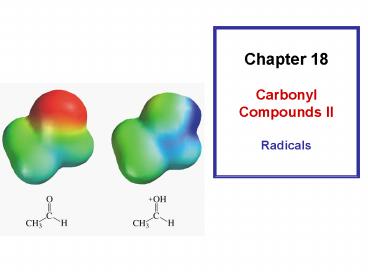Carbonyl Compounds II - PowerPoint PPT Presentation
1 / 57
Title:
Carbonyl Compounds II
Description:
Ketones have greater steric crowding in their transition ... Steric factors contribute to the reactivity of an aldehyde ... addition is slowed down by steric ... – PowerPoint PPT presentation
Number of Views:250
Avg rating:3.0/5.0
Title: Carbonyl Compounds II
1
Chapter 18 Carbonyl Compounds II Radicals
2
Nomenclature of Aldehydes
3
If the aldehyde group is attached to a ring,
4
If a compound has two functional groups, the one
with the lowest priority is indicated by its
prefix
5
Nomenclature of Ketones
6
(No Transcript)
7
If a ketone has a second functional group of
higher priority,
8
An aldehyde has a greater partial positive charge
on its carbonyl carbon than does a ketone
9
(No Transcript)
10
- Steric factors contribute to the reactivity of
an aldehyde
- The carbonyl carbon of an aldehyde is more
accessible - to the nucleophile
- Ketones have greater steric crowding in their
transition - states, so they have less stable transition
states
11
Aldehydes and ketones react with nucleophiles to
form addition products nucleophile addition
reactions
12
(No Transcript)
13
If the nucleophile that adds to the aldehyde or
ketone is an O or an N, a nucleophilic
additionelimination reaction will occur
14
Formation of a New CarbonCarbon Bond Using
Grignard Reagents
Grignard reagents react with aldehydes, ketones,
and carboxylic acid derivatives
15
(No Transcript)
16
(No Transcript)
17
Reaction with Acetylide Ions
18
(No Transcript)
19
In basic solution, a cyanohydrin is converted
back to the carbonyl compound
20
Synthesis Using Cyanohydrin
21
Reduction by Hydride Ion
22
(No Transcript)
23
(No Transcript)
24
Utilization of DIBAL to Control the Reduction
Reaction
25
The reduction of a carboxylic acid with LiAlH4
forms a single primary alcohol
Acyl chloride is also reduced by LiAlH4 to yield
an alcohol
26
An amide is reduced by LiAlH4 to an amine
27
Aldehydes and ketones react with a primary amine
to form an imine
This is a nucleophilic additionelimination
reaction The pH of the reaction must be
controlled
28
Dependence of the rate of the reaction of acetone
with hydroxylamine on the pH of the reaction a
pH rate profile
29
Aldehydes and ketones react with secondary amines
to form enamines
30
Formation of Imine Derivatives
31
Deoxygenation of the Carbonyl Group
32
Water adds to an aldehyde or ketone to form a
hydrate
33
(No Transcript)
34
Why is there such a difference in the Keq values?
35
The equilibrium constant for the reaction depends
on the relative stabilities of the reactants and
products
36
Addition of an Alcohol to an Aldehyde or a Ketone
37
Utilization of Protecting Groups in Synthesis
LiAlH4 will reduce the ester to yield an alcohol,
but the keto group will also be reduced
38
The keto group is protected as a ketal in this
synthesis
39
The more reactive aldehyde is protected with the
diol before reaction with the Grignard reagent
40
- The OH group in an alcohol can be protected as a
- trimethylsilyl ether
- The OH group in a carboxylic acid can be
protected as - an ester
- An amino group can be protected with an acetyl
group
41
Addition of Sulfur Nucleophiles
42
Desulfurization replaces the CS bonds with CH
bonds
43
Formation of Alkenes The Wittig Reaction
44
(No Transcript)
45
Preparation of the Phosphonium Ylide
If two sets of reagents are available for the
synthesis of an alkene, it is better to use the
one that requires the less sterically hindered
alkyl halides
46
- The Wittig reaction is completely regioselective
- This reaction is the best way to make a terminal
alkene
- Stable ylides form primarily E isomers, and
unstabilized - ylides form primarily Z isomers
- Stable ylides have a group (CO) that can share
the - carbanions negative charge
47
Stereochemistry of Nucleophilic Addition Reaction
48
(No Transcript)
49
(No Transcript)
50
(No Transcript)
51
(No Transcript)
52
(No Transcript)
53
(No Transcript)
54
(No Transcript)
55
- Nucleophiles that form unstable addition
products form - conjugated addition products, because the
conjugate - addition is not reversible
- Nucleophiles that form stable addition products
can - form direct addition products or conjugate
addition - products
- If the rate of direct addition is slowed down by
steric - hindrance, a Grignard reagent will form the
conjugate - addition product
56
Nucleophilic Addition to a,b-Unsaturated
Carboxylic Acid Derivatives
57
Enzyme-Catalyzed Additions to a,b-Unsaturated
Carbonyl Compounds































